

Suunto Blog
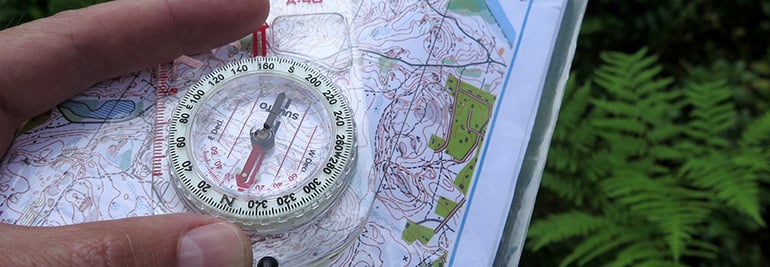
ORIENTATE YOURSELF WITH A COMPASS
Using a map and compass may seem antiquated but it could save your life. So when traveling in the backcountry it is always a good idea to carry a map and a compass with you even if you have a GPS device. But they are only good if you know how to use them!
1. ORIENTATE YOURSELF
With map-reading the most important thing is to orientate yourself on the map and then to always keep track of where you are on the map. Use the features on the map to find your location. Look at the big features first, like peaks, lakes, roads and then look at the smaller details such as buildings, footpaths or small rivers etc.
Use the altimeter function to help pinpoint your location. Once you know your height you can use the contour lines to fix where you are more precisely. Spend some time making sure the features on the ground match those on the map. It’s very easy to convince yourself otherwise! Top tip: it can take a long time to orientate yourself. So once you’ve done it, fold the map in such a way that your location is visible. To be even more efficient, do what orienteering racers do: carry the map with your thumb on your position.
2. ORIENTATING THE MAP
To be able to read a map, you must first orient it. Turn your map into a position in which the details on the map correspond with the landscape in front of you. The orientation of a map is the key to reconciling the map with the terrain.
To orientate the map, place the compass on the map and rotate the map to align the magnetic compass needle with the northerly grid lines on the map, making sure the red end of the needle points to north on the map.
Also read: Tutorial Tuesday: Where am I? Determining your location with an Ambit.
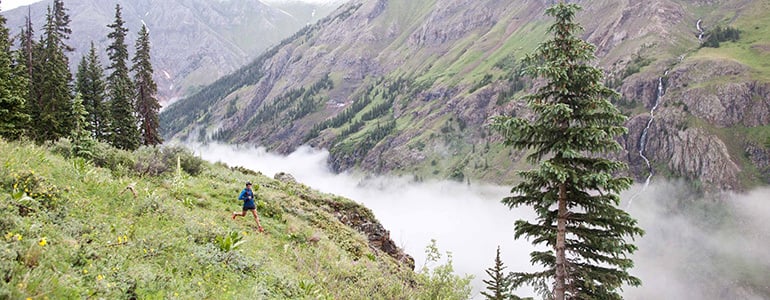
Go mountaineering to stay fresh, says Kilian
With two big victories this summer, trail running legend Kilian Jornet is planning different mountain adventures to mix it up and stay fresh.
Breaking records is what Kilian Jornet has done over and over again. Aside from setting speed records on giant mountains all over the world, the 27-year-old Spaniard has busted a number of ultra marathon race records. In June, he won the iconic Mount Marathon Race in Alaska, breaking the men’s course record in the process.
Then, only a couple of weeks later, he won the tough Hardrock 100 Race, breaking the counter clockwise record after winning and breaking the clockwise course record just the previous year. “I have been racing for 15 years and I have been doing a lot of races and what attracts me to a race now is not only that the level of competition is high, but that everything else around it is nice too,” Kilian says. “Both the Mount Marathon Race and Hardrock 100 races have amazing trail and incredible ambience.”
The Hardock 100. Photo from file ©Blake Wood.
Rather than more racing this summer, if the weather stays good Kilian aims to carry out two mountaineering projects in the European Alps. Mountaineering is one of the key ways Kilian likes to recovery after big tough running races and stay mentally fresh, which is something he says is crucial for all athletes. Click here to find out about new recovery features for Ambit3 watches.“To help me recover mentally from racing, I like to do some mountaineering activities to feel different feelings than just running,” he says. “I ran less than 200 km in the build up to Hardrock because I was climbing instead.
Midnightsun Ersfjordtraversen
Ersfjord traversen is one of the most beautiful ridges crossings I have ever done. A scrambling, climbing and some glaciers crossing on the side of the fjords.Enjoy the video!!#Alpinrunning #Expandyourplayground
Posted by Kilian Jornet on Monday, 20 July 2015
“I was keeping myself good through mountaineering so when I came to the race I was mentally fresh and physically prepared. If you focus too hard on one thing for too long you can get tired of it.“You see people who are doing a lot of long races and who keep this up for one or two years and then, boom, they’re down, injured and no longer reach a good level. It’s important to never do too many long races every year because after one, two or three years it can be really hard to recover. I think 200 or 300 miles a year is the limit.”
Main image shared via Kilian Jornet
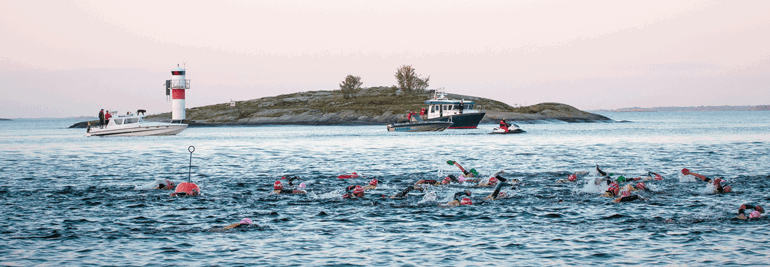
SIX USEFUL TIPS FOR SWIM-RUNNING
Swim run events are great endurance challenges – and a super fun way to enjoy a summer’s day. The number one event in the world is the Ötillö Swim Run World Championship in Stockholm’s archipelago in September. In Ötillö, teams of two will open-water swim and trail run a distance of 75 km across 26 islands.
To make the challenge even bigger, the competitors have to carry everything they need with them through out the race, which results in some interesting and novel gear solutions – they swim with their running shoes and run in wetsuits.
German Armin Hummel and Finn Juha Lindfors are preparing for their third attempt at one of the toughest endurance challenges in the world.
Here Armin and Juha share six useful tips to get you through your swim-run more smoothly. Enjoy!
Less is more
“Focus on what is really needed. In Ötillö, there are plenty of feed stations along the way – though sometimes it can be a lengthy break between them. Make sure you take enough drinks and food at the feed stations. It will be a looong day!”
“You can take some fuel with you if you can carry it, but at least for us there is no need for a hydration pack. A soft flask might be a good idea as it can be stuffed inside your wetsuit once empty. If you need to worry about a backpack you probably aren’t focusing on the race.”
Practice the transitions
“Train switching from running to swimming, and the other way round. There are many transitions and if you spend an extra minute at each, you end up losing a whole hour. Quick transitions are also a key reason to minimize equipment.”
Choose the right shoes
“Your swim-run shoes and socks should be fast drying and comfortable also when they are wet. Good grip on slippery, wet rocks is essential.”
“We have tried regular running shoes, trail running shoes and trail running shoes with spikes. Shoes without spikes seem to work better for us on the rocks. So this year both of us will be using trail running shoes without spikes.”
Don’t swim any extra distance
“Make sure you always look for the point where you will get out of water. Sometimes currents can be strong and, if you don´t look frequently, you can be off-course quite fast. Frequent position checks are important, especially on the long swims.”
“As it is a pair sport, it might also be enough that one navigates and the other one follows. Consider this especially, if one in your team is clearly a stronger swimmer.”
Consider using paddles and pull buoys
“The first time we raced Ötillö we used pull buoys to improve buoyancy, but last year we didn’t. We are still experimenting on this. We are not sure if there is a benefit for us. “
“Generally you need to be a really strong swimmer to swim without pull buoys, as shoes are on all the time. Well, some do actually take their shoes off at least for the longer swims.”
“Paddles give you extra force especially when there are waves and currents. However make sure you train with them before so your shoulders are used to the extra stress.”
Always move, never stop
“In Ötillö, there is lots of running. Try to maintain a steady pace rather than going superfast in the beginning and then not making it in the end. If you start walking, it is hard to get back to running again.”
“Make also sure that you don´t go off-track and follow the markers. We use our Suunto Ambit3’s to know the distances during stages.”
All photos by ÖTILLÖ14
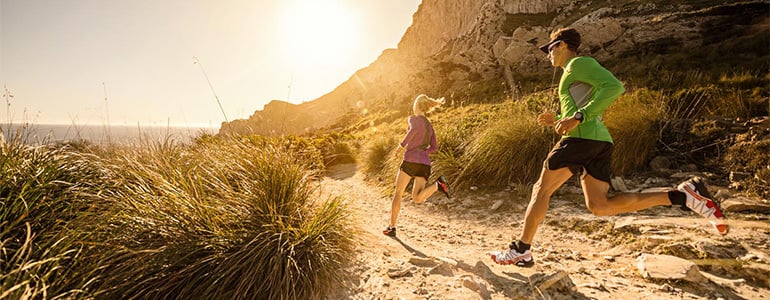
Six runners win Suunto Ambit3 Run watches
After a huge response on Instagram and great feedback from professional running coaches Koop and Nick, the How do I run? contest has closed and six lucky runners have each won a Suunto Ambit3 Run watch.
Dozens of people shared clips of themselves running on Instagram to take part in our How do I run? contest. Carmichael Training System coaches Koop and Nick were run off their feet trying to analyze as many clips as possible.
Click here to read Koop and Nick’s 8 tips to become a better runner
© Droz Photo/Rosso Damien
The feedback from the coaches wasn’t only critical, much was positive. Many runners showed great overall form and need to work on one or two small points to improve their technique and performance. Check out the Instagram clips below for a taste of the action.
All of the runners who had their running analyzed by Koop and Nick went into a draw to win one of six Suunto Ambit3 Run watches. Instagrammers @stephenskinner6, @mbhuyko, @mish_glover, @faisnaini, @renatacavalleiro and @gofknxplore have each won a watch! Congratulations!
To also help runners improve their running performance, Suunto has released a new running performance level to its Ambit watches. The new feature is a combined measurement of physical fitness and running efficiency that guides training both during a single exercise and in the long run.
Click here to learn how to use Ambit3’s new running performance feature
Feedback from the coaches
More than a chance to win an excelent equipment, a chance to hear from the experts about how is my running! Love Suunto #SuuntoRun #skechersperformance #corracomonunca
A video posted by Renata Cavalleiro (@renatacavalleiro) on Jul 10, 2015 at 7:14pm PDT
Coach Nick says: You have a really nice forward lean when you're running. Definitely try to maintain that. Like a lot of runners, you are landing slightly on your heels and your feet are contacting the ground out in front of your body. If you can try to put your feet down underneath your hips that will let you move forward with greater efficiency. Bringing your contact point backwards a little should also make it easier to land on your mid foot rather than your heels, which is what you want. Mid foot strike directly beneath your hips. Keep your current forward lean and you're going to be faster!
In running, it doesn't matter whether you come in first, in the middle of the pack, or last. You can say, 'I have finished.' There is a lot of satisfaction in that. #SuuntoRun
A video posted by Muhammad Budiansyah (@mbhuyko) on Jul 13, 2015 at 5:41am PDT
Coach Koop says: You have very good form overall. Your gaze is straight forward, arms and shoulders are relaxed and you have a nice midfoot strike that is directly under your hips. I honestly would not change a thing here! Great work!
#suuntorun #suunto HELP ME! Urgent advices are needed to better run :) I would like to run at least 10 kms every 3 days however without GPS watch it is hard to measure my performance. I hope I will have a chance to win one!
A video posted by Évi Matola (@evimatola) on Jul 10, 2015 at 11:25am PDT
Coach Nick says: Your running technique is looking really good! Your foot strike is great. You're landing on the ball of your foot, and it appears that when your feet land, they're underneath your center of mass (hips). Those are definitely the most important pieces of the puzzle. Make sure you're leaning forward slightly while you run. And lastly, make sure that your arms aren't crossing in front of your body TOO much. Get all of your limbs moving in the direction you want to travel. Keep up the good work.
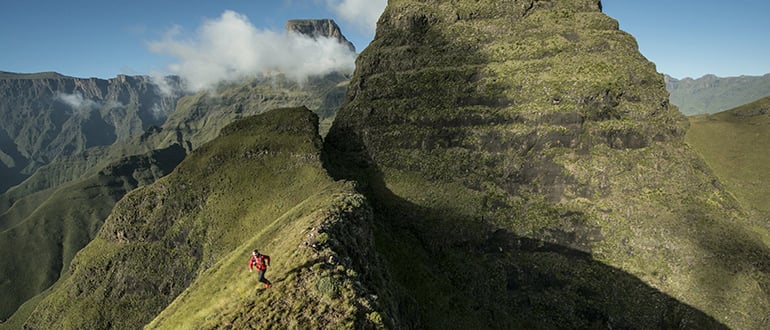
Ryan Sandes: How to recover like a pro from an ultra race
In this final installment of our three part series on running ultra mararthons, Suunto ambassador and champion ultra runner Ryan Sandes shares his tips for recovery.
Many ultra runners have got a personality-type that drives them to go from one race to the next, from one training cycle to another, but after two years they get completely burned out. Even if you feel on top of the world after finishing a big race, and want to get straight back into training, your body and legs need plenty of time to recover. Follow these post-race tips to ensure you have a full recovery.
Click here and here to read Ryan's other tips for going the ultra distance
Recovery tips for the day after the race
Drink plenty of water throughout the day and add some electrolytes to it. Eat lots of healthy whole foods – rich in protein and good fats – to help your body recover.
Go for any easy run to get your legs moving and to flush out the lactic acid.
Relax in a sauna or have a hot bath, as the heat will loosen up your tight muscles.
Most importantly, allow yourself to mentally switch off and celebrate your achievement. Have a few drinks and let it all go as this is important for recovery.
©Craig Kolesky/Red Bull Content Pool
Click here to find out about the features in Suunto's Ambit3 to help you recover
Recovery three days to a week after the race
I would suggest doing no running for the week after the race because your mind and body will need a break. If you start to feel edgy, go for a hike or cross train, but don't run.
Keep eating healthy as your body is still in recovery mode.
Get a massage or two and spend more time in the sauna or hot tub.
Do some mobility and stretching work.
Recovery a fortnight to a month after the race
After a week of no running, the second week you can start running again, but take it very easy. I would suggest not doing any hard sessions for at least three to four weeks after your race.
I find doing some barefoot running with a few drills and some plyometric exercises for 20 to 30 minutes on a grass field really helps my legs bounce back.
Pool running is a really gentle activity to aid recovery and help your body get moving again.
For three days to a week after the race you can eat as much as you want, but after that don't overeat as you don't want to put on unnecessary weight.

Divers retrieve a piece of WWII history
Suunto ambassador and underwater explorer Jill Heinerth documented a sensitive dive mission to recover an important piece of history.
A dive team successfully retrieved the sextant from a WWII wreck and have delivered it to a Newfoundland museum for posterity.
Diver Luc Michel discovered the sextant last year.
Suunto ambassador Jill Heinerth documented the dive and says it was a “huge privilege” being part of the team.
“The fear was that if left in place, in the open, underwater, [the sextant] would disappear into somebody's private collection which is not just illegal, but also a loss of cultural history,” Jill says. “Sharing the history and ensuring the safety of this important artifact for the museum was a huge privilege.”
Meet Jill face-to-face in episode 7 of the #SuuntoAdventure video series
The recovered sextant is being restored before being displayed at Newfoundland museum.
The sextant belonged to the SS Rose Castle, a steam merchant ship, that a German U-Boat sank during WWII while it was anchored at Bell Island, off the coast of Newfoundland. Iron ore mines on Bell Island supplied Cape Breton's steel mills, which accounted for one-third of Canada's steel production. Seeking to disrupt production, the German U-Boat entered the harbor at 3am one morning in September 1942 and sank the SS Castle Rose with two torpedoes before sinking French vessel PLM 27 and escaping into the darkness. The Castle Rose took 28 crewmembers down with her, five who were Newfoundlanders.
“We dive with great reverence, understanding that this site is essentially a war grave,” Jill says. “The many men who died were never expecting to be targets of the war and within site of some of their homes.”
The SS Lord Strathcona was also sunk in 1942. Above, divers explore its wreck.
Diver Luc Michel, from St. Pierre et Miquelon of Newfoundland, located the sextant last year. After restoration, the sextant will be displayed at The Rooms, a Newfoundland cultural center and museum.
Click here to read about Jill's journey as an underwater explorer.










































































